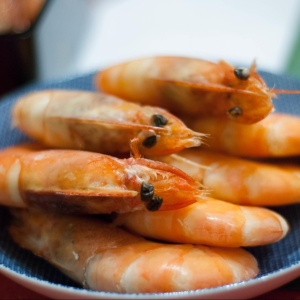
This paper quantifies the resource use implications of replacing fishmeal with plant-based ingredients in the feed used to farm shrimp. It finds that increasing the proportion of plant-based ingredients in shrimp feed could reduce pressure on marine resources, at the cost of increased use of freshwater, land and fertiliser.
The study examines substitution of fishmeal with either “common” plants (mainly wheat and soybean) or “alternative plants” (pea protein, rapeseed meal, corn gluten and corn oil) for two different shrimp species (Litopenaeus vannamei - whiteleg shrimp - and Penaeus monodon - black tiger shrimp).
The results show that, as the proportion of fishmeal in the shrimp feed decreases, the demand for land, freshwater and fertiliser (nitrogen and phosphorus) generally increases and the demand for fish generally decreases. As an example, the figure below illustrates how demand for land changes as shrimp feed composition changes. LV and PM refer to the two different shrimp species, while LV1 and PM1 refer to substitution with “common” plants and LV2 and PM2 refer to substitution with “alternative” plants (see the previous paragraph for definitions). Substitution with “alternative” plants leads to greater land demand than when substituting with “common” plants, because rapeseed meal and pea protein concentrate need more land to produce than soybean meal concentrate and wheat (the latter two being used in the “common” plant scenario).
 Image: Figure 2, Malcorps et al. Minimum, mean, and maximum land demand (ha/MT) for the baselines and five substitution levels in two scenarios and for two species. The y-axis represents the global mean land demand, and the bars indicate the range (min/max) in land demand of a combination of ingredients in the feed formulations.
Image: Figure 2, Malcorps et al. Minimum, mean, and maximum land demand (ha/MT) for the baselines and five substitution levels in two scenarios and for two species. The y-axis represents the global mean land demand, and the bars indicate the range (min/max) in land demand of a combination of ingredients in the feed formulations.
Due to the trade-offs between fish use and other resources, the paper concludes that “a shift from fishmeal to plant ingredients should not be taken for granted as a sustainable solution to meeting a rapidly expanding (shrimp) aquaculture industry.” The paper also notes that the use of fishmeal in aquaculture nevertheless needs to be optimised, for example through improving feed conversion ratios or investigating other novel protein sources such as microbial biomass or insects.
Abstract
Aquaculture is central in meeting expanding global demands for shrimp consumption. Consequently, increasing feed use is mainly responsible for the overall environmental impact of aquaculture production. Significant amounts of fishmeal are included in shrimp diets, causing dependency on finite marine resources. Driven by economic incentives, terrestrial plant ingredients are widely viewed as sustainable alternatives. Incremental fishmeal substitution by plant ingredients in shrimp feed was modeled and effects on marine and terrestrial resources such as fish, land, freshwater, nitrogen, and phosphorus were assessed. We find that complete substitution of 20–30% fishmeal totals could lead to increasing demand for freshwater (up to 63%), land (up to 81%), and phosphorus (up to 83%), while other substitution rates lead to proportionally lower impacts. These findings suggest additional pressures on essential agricultural resources with associated socio-economic and environmental effects as a trade-off to pressures on finite marine resources. Even though the production of shrimp feed (or aquafeed in general) utilizes only a small percentage of the global crop production, the findings indicate that the sustainability of substituting fishmeal by plant ingredients should not be taken for granted, especially since aquaculture has been one of the fastest growing food sectors. Therefore, the importance of utilizing by-products and novel ingredients such as microbial biomass, algae, and insect meals in mitigating the use of marine and terrestrial resources is discussed.
Reference
Malcorps, W., Kok, B., van‘t Land, M., Fritz, M., van Doren, D., Servin, K., van der Heijden, P., Palmer, R., Auchterlonie, N.A., Rietkerk, M. and Santos, M.J., 2019. The sustainability conundrum of fishmeal substitution by plant ingredients in shrimp feeds. Sustainability, 11(4), p.1212.
Read the full paper here. See also the Foodsource resource How far could changes in production practices reduce GHG emissions?







Post a new comment »